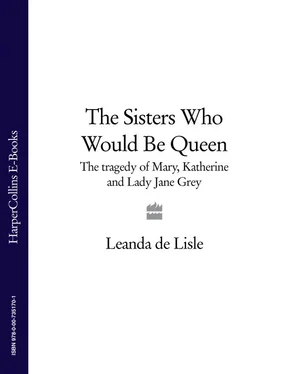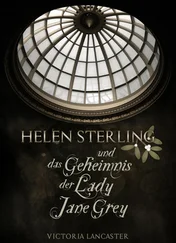With her pursed lips and sandy eyelashes, Jane Seymour seems a poor replacement for Anne Boleyn, whose black eyes, it was said, ‘could read the secrets of a man’s heart’, but like her predecessor, Jane Seymour was a ruthless seductress. 14 Her betrothal to Henry was announced only the day after Anne was executed. Having got her king it was her performance as a brood mare that was now important. In this too, however, she was showing marked success. A pregnancy had been evident for weeks and on 27th May the rumours were confirmed with a Te Deum sung at St Paul’s Cathedral ‘for joy of the Queen’s quickening with child’. 15 It remained to be seen whether Jane Seymour would give the King the son he wanted, but in choosing her as godmother to their new daughter, Frances and Harry Dorset had offered a vote of confidence, and although they could not know it, the Seymour family would remain closely linked to their own, one way or another, thereafter.
About a fortnight after the christening, Frances had her first day out of bed and dressed in one of her finest nightgowns for a celebratory party. The royal tailor advised damask or satin, worn with an ermine-trimmed bonnet and waistcoat, allowing the wearer to keep warm as well as look good, for visiting female friends and relations. Frances had a younger sister, Eleanor, married to Lord Clifford, and an equally young stepmother. Frances’s mother had died on Midsummer’s Day in June 1533, and her father had wasted little time before remarrying. The bride he had chosen was his fourteen-year-old ward, the heiress, Katherine Willoughby. He was then forty-nine, and the muscles of the champion jouster, like those of his friend the King, had begun to turn to fat. Frances would doubtless have wished her father had waited longer and made a different choice: the new Duchess of Suffolk had been raised alongside her like a sister since the age of seven. But Frances had accepted what she could not change and remained close to her childhood friend, who was now pregnant with the second of Frances’s half-brothers, Charles Brandon. After the party was over, Frances could venture beyond her chambers to the nursery and other rooms in the house, until the lying-in concluded at last when Jane was about a month old with the ‘churching’ - a religious service of thanksgiving and purification that ended with Frances being sprinkled with holy water. ‘Purge me with hyssop, and I shall be clean,’ she prayed; ‘wash me, and I shall be whiter than snow.’ Frances then was ready to return to Henry’s court. 16 Here, the care and blessings, showered on most new mothers, were in stark contrast to the treatment Henry had meted out to the Queens who had borne his children. If his third wife, Jane Seymour, had any fears about the future, however, there was little sign of them before her own lying-in began. She made her last public appearance on 16th September at Hampton Court. There was a grand procession into Mass at the royal chapel (which still survives, the ceiling a brilliant blue, studded with golden stars), and afterwards the court gathered in the vast space of the Watching Chamber (which also remains) to enjoy cold, spiced wine. There had been months of building work carried out in anticipation of the royal birth, and the heady scents of clove and cinnamon mixed with those of burnt brick and newly hewn wood. Once Jane Seymour disappeared to her chamber, however, so most of the court left the palace. There had been an outbreak of plague that summer and they were encouraged to go home.
There persists a myth that Lady Jane Grey was born during the subsequent three weeks of the Queen’s confinement, at the Grey family’s principal seat of Bradgate Manor in Leicestershire. Dorset’s mother, the dowager marchioness, was, however, installed at Bradgate until January 1538 and Frances was busy enjoying herself, not lying in bed. On 11th October 1537, when news reached her that Jane Seymour was in labour, she was being entertained at the house of a friend and her husband was on their estate at Stebbing in Essex. 17 Dorset left immediately for London, where a procession was already being organised for priests and clerks, the mayor and aldermen, to pray for the Queen. It seemed their prayers were soon answered. At two o’clock the following morning, on the eve of the feast of St Edward, Henry VIII’s longed-for son, soon also to be christened Edward, was born. By 9 a.m. on that pivotal morning, Dorset was with the large crowd at the door of the medieval church of St Paul’s, singing the Te Deum. When the great hymn of thanks was finished volleys of gunfire were shot from the Tower and hogsheads of wine were set out for the poor to drink. The long-term security and peace of the nation hinged on having an undisputed succession and people of all religious persuasions now rejoiced at the birth of their prince. 18
As the nation celebrated in the days ahead, Frances joined Dorset and together they made frantic efforts to arrange for permission to be at court for Edward’s christening. It was an event the entire nobility and royal family wished to attend, and Frances’s father had been invited to be godfather at the confirmation that followed immediately after the baptism. But, to their frustration, they found that they were not to be allowed back to Hampton Court. There had been several plague deaths in Croydon, where Dorset’s mother had a property. They hadn’t visited her recently, but no chances were being taken with the possible spread of disease to the palace. 19
Such precautions would not save the Queen. Days later Jane Seymour suffered a massive haemorrhage, probably caused by the retention of part of the placenta in her womb. She was given the last rites two days after her son’s christening and died on 24th October. Frances was bequeathed several pieces of the Queen’s jewellery, pomanders and other trinkets, 20 and while she and Dorset had missed the royal baptism, they took leading parts in the state funeral in November. Dorset, his father-in-law the Duke of Suffolk, and four other courtiers, rode alongside the horse-drawn chariot that bore Jane Seymour’s coffin in procession to Windsor. It was surmounted by her effigy, painted to look lifelike and dressed in robes of state, with her hair loose, and rings on her fingers set with precious stones: the wooden dummy of a woman who had served her purpose. Riding immediately behind it, on a horse trapped in black, was the King’s elder daughter, the Princess Mary, who acted as chief mourner. The child who, thirteen years earlier, when her father was almost killed at the joust, had been his undisputed heir, was now a grown woman, twenty-one and pretty, with his pink and white complexion, and a painfully thin frame. She had seen her late mother humiliated in her father’s quest for a son, and Parliament brought into the divine process of the succession to deny her her birthright. But the vagaries of fate are uncertain. Under the Act of Succession of the previous year, Henry had been granted the right to nominate his heirs, and Mary knew she could yet be restored in line to the throne, despite having been declared illegitimate.
Behind Mary, sitting in the first of the chariots bearing the great ladies of the court, sat Frances, dressed in black and attended by footmen in demi-gowns. 21 The procession then continued with the mourners in descending order of precedence so that at its very end even the servants walked according to the rank of their masters. ‘The heavens themselves, the planets and this centre, Observe degree, priority and place,’ Shakespeare wrote later in Troilus and Cressida ;
Take but degree away, untune that string, And hark, what discord follows…Strength should be lord to imbecility, And the rude son should strike his father dead. This chaos, when degree is suffocate, Follows the choking. 22
Читать дальше












